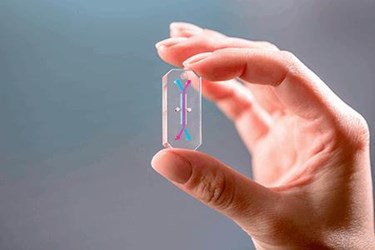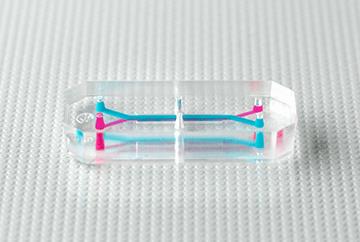Can Organs-On-Chips Repair The Flawed System Of Drug Discovery?

By Trisha Gladd, Life Science Connect Editor
There is an ecosystem of many stakeholders who play a role in the discovery of new drugs, and each of them have a vested interest in making the drug discovery system work successfully and efficiently. Yet, the realities of a flawed system are evident in the facts and figures. A Phase 1 clinical trial for one compound can cost close to $15 million and take years to complete. Data published on www.fdareview.org also shows that only about 10 percent of drugs entering Phase 1 trials actually make it to market, which translates to considerable financial losses for those in the other 90 percent.
Recently, a wide range of these stakeholders – from pharmaceutical companies and academic researchers, to disease foundations and CROs – have signed on to work with Emulate, Inc., a privately held company at the forefront of a new technology, called ‘Organs-on-Chips.’ James Coon, CEO of Emulate, and his team of scientific researchers, designers and engineers are aiming to change the way drug candidates are evaluated in the laboratory by using Organs-on-Chips technology an alternative to today’s cell culture and animal testing techniques. In the past week, two new collaborators have joined forces with Emulate: a CRO, Covance Drug Development, and a major cancer research center, the Ellison Institute for Transformative Medicine at USC. This adds to the growing list of partners – including Johnson & Johnson, Merck, the Michael J. Fox Foundation for Parkinson’s Disease, and the government defense agency DARPA – who are putting their hopes and expertise on the line to advance Organs-on-Chips technology into the mainstream of the drug-development process.
 Coon says one of the reasons so few drugs make it to market is due to the conventional in vitro models and animal models currently being used by the pharmaceutical industry. To identify viable drug candidates, these models rely on data points from static human cell cultures in plastic dishes that do not represent the broader living biology of human tissues and organ systems, or on studies in animals that do not always directly translate to human biology. Organs-on-Chips technology offers a new approach. By placing living human cells in an engineered microenvironment that recreates what’s happening within tissue systems, Coon says the technology offers the ability to create the smallest functional unit of a human organ, which gives a biological context that is much more effective at predicting human response than today’s cell cultures or animal testing.
Coon says one of the reasons so few drugs make it to market is due to the conventional in vitro models and animal models currently being used by the pharmaceutical industry. To identify viable drug candidates, these models rely on data points from static human cell cultures in plastic dishes that do not represent the broader living biology of human tissues and organ systems, or on studies in animals that do not always directly translate to human biology. Organs-on-Chips technology offers a new approach. By placing living human cells in an engineered microenvironment that recreates what’s happening within tissue systems, Coon says the technology offers the ability to create the smallest functional unit of a human organ, which gives a biological context that is much more effective at predicting human response than today’s cell cultures or animal testing.
Organs-on-Chip is a technology originally designed by Donald E. Ingber M.D. Ph.D., founding director of The Wyss Institute for Biologically Inspired Engineering at Harvard University, and Dan Dongeun Huh, Ph.D., assistant professor in the department of engineering at the University of Pennsylvania, that combines microfabrication techniques and engineering principals to create living, functioning human organs inside engineered microenvironments. Measuring in a size similar to a AA battery, each chip is made of a clear flexible polymer that contains tiny hollow channels lined by living human cells. Just as if cells from a patient’s body were biopsied and then studied, these translucent devices can be created by scientists to use as a window into the inner workings of human organs.
Since spinning out of The Wyss Institute for Biologically Inspired Engineering in July 2014, Emulate has evolved its Organs-on-Chips technology to become a commercially-viable product platform for use in industry. By housing the Organs-on-Chips within an automated system Emulate offers a way for researchers and product developers to not only conduct experiments that are predictive of normal human physiology, but they also can create different disease states within the Organs-on-Chips to help determine appropriate therapeutic intervention. This lab-ready automated system includes three components: the Organs-on-Chips, the instrumentation that automates the use of those chips, and the software apps that allows scientists to collect and analyze data. Because Emulate is integrating their Organs-on-Chips technology into a ‘plug-and-play’ system, end users can easily conduct experiments to meet customized needs within their own labs.
“In collaborations announced over the last year, industry leaders, such as Merck, the Michael J. Fox Foundation and Johnson & Johnson, are recognizing that the Organs-on-Chips technology can be valuable in predicting human response in applications throughout the drug development process and are now engaged in using the technology for a wider range of applications,” says Coon. “This includes early-stage processes, such as discovering new drug targets and understanding disease mechanisms, as well as late-stage testing of the efficacy and safety of new drug compounds.”
How Would Organs-on-Chips Impact The Future Of Animal Testing?
 While it seems Organs-on-Chips has the potential to eliminate animal testing, Coon says that, as of right now, that is unlikely. “We live in a world where there is a regulatory system in place that is built around standards using animal testing,” he explains. “As a result, some of our early partners are using Organs-on-Chips to augment their existing pre-clinical models, and over time, we may be able to increasingly replace animals in the development process.” When it comes to the three guiding principles supporting the humane use of animal testing in scientific research—replace, reduce, and refine—Coon says Organs-on-Chips can play a role in each area. “By serving in a role side-by-side with animal testing, the technology can generate human-relevant data that has the ability to guide the refinement of the animal models that are selected for regulatory submissions,” explains Coon. “This could ultimately reduce the ineffective or unnecessary animal studies as well as the number of animals required.”
While it seems Organs-on-Chips has the potential to eliminate animal testing, Coon says that, as of right now, that is unlikely. “We live in a world where there is a regulatory system in place that is built around standards using animal testing,” he explains. “As a result, some of our early partners are using Organs-on-Chips to augment their existing pre-clinical models, and over time, we may be able to increasingly replace animals in the development process.” When it comes to the three guiding principles supporting the humane use of animal testing in scientific research—replace, reduce, and refine—Coon says Organs-on-Chips can play a role in each area. “By serving in a role side-by-side with animal testing, the technology can generate human-relevant data that has the ability to guide the refinement of the animal models that are selected for regulatory submissions,” explains Coon. “This could ultimately reduce the ineffective or unnecessary animal studies as well as the number of animals required.”
Consistent with the way new standards are accepted for regulatory filings with FDA and other agencies, the Organs-on-Chips technology will be evaluated for future adoption for regulatory uses as the body of data using Organs-on-Chips continues to grow over time. As of right now, it is a technology that is used part of the R&D process, and continues to be evaluated for adoption as a standard practice for regulatory filings.
Industry Partnerships Drive Commercialization Potential
In 2015, Organs-on-Chips was named the overall winner of the London Design Museum’s Design of the Year award. This marked the first time this award was presented to a product from the field of medicine. Some of pharma’s biggest names also have recognized the potential of this technology. As mentioned, Emulate has entered into a strategic collaboration with Merck. Together, the two companies are working to deploy Organs-on-Chips across certain Merck drug discovery programs with the goal of improving models of human inflammatory diseases and better predicting human response of therapeutic candidates. In addition, Johnson & Johnson Innovation and Janssen Biotech are also in a strategic collaboration with Emulate to use Organs-on-Chips to drive the clinical goals for three Janssen R&D programs.
When it comes to partnerships, Coon says one of the things they have been careful about very early on is not chasing money. “Our goal is to strategically align with companies that help us advance our core business, which is to develop the technology platform, the instrumentation, and the software,” he explains. “All of our partners have brought not just funding but also expertise.,. These partnerships allow us to have the kind of insight that offers a jump-start to move forward in different therapeutic areas we wouldn’t normally have access to.”
Emulate continues to have an active collaboration with The Wyss Institute as well. This includes a $37 million agreement between The Wyss Institute and the Defense Advanced Research Projects Agency (DARPA) to integrate 10 human Organs-on-Chips to study complex human physiology. This project provides foundational research that opened the door for Emulate to envision its overall mission, which is to develop and commercialize the Organs-on-Chips technology into an automated system that is used by industry to emulate human biology, in order to understand how diseases, medicines, chemicals and foods affect human health. “Everything we've done with DARPA has given us the insight to not only be able to deliver technically on the science and the biology, but to also scale manufacturing of the chips up and create a stronger foundation for product development,” says Coon.
Emulate is expanding its current product portfolio, which includes Lung-Chip, Liver-Chip, Intestine-Chip and Kidney-Chip, for additional organs such as Skin-Chip, Heart-Chip, Brain-Chip. As the product platform becomes widely adopted and more researchers are using it across multiple industries, Emulate will need to be able to produce millions of chips to move closer to launching Organs-on-Chips as a commercial product. A major step toward the commercialization of Organs-on-Chips was made earlier this year when Emulate secured $28 million of its Series B financing to accelerate its technology into a commercially-available “Human Emulation System.” As stated in a press release on its site, the financing will position Emulate “to accelerate its R&D effort, expedite the launch of its products and expand strategic relationships with industry and academic partners in order to evolve the company towards profitability.”
Since the early stages of research at the Wyss Institute in 2009 to Emulate’s founding in July 2014, experts from design, engineering, medicine, biology, and the physical sciences have shared a common goal of working together to develop Organs-on-Chips to create transformative change. As Emulate continues to advance its product platform, the industry will move closer to a solution that helps develop new therapeutic solutions for patients and offers a less costly way to develop innovative medicines. In addition, the company is also currently working with partners to develop Organs-on-Chips with individual patient stem cells, for use in precision medicine and personalized health applications. Through a focus on improved disease understanding and accuracy of human response, Organs-on-Chips drives efficiency at all levels of drug development and offers possibilities in patient care the industry has yet to see.
